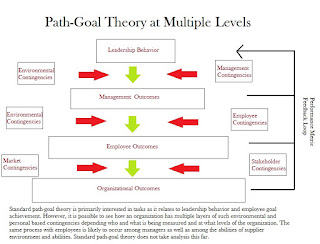Path-goal leadership is
a process of helping employees find appropriate paths to meet goals that align
with organizational objectives. Leaders who have the ability to inspire their
employees and develop these mental connections between performance, paths, and
rewards can expect to see higher levels of organizational achievement. Yet
defining the right strategies without the right leadership does little if
employees are not empowered to act and progress to new levels.
Path-goal theory has
two main objectives such as a) identifying roles and behaviors of effective
leaders and b) exploring situational contingencies that modify those behaviors
(Barling et. al, 2011). In essence, the leader’s behavior becomes a primer to
the situational context in which employees exist. When the leadership behavior is
effective and the situational contingencies are positive and in alignment
there should be a corresponding increase in performance.
The theory is often further
defined into situational factors and employee characteristics. The situational
factors are those that create the right environment for performance while
employee characteristics are those qualities that are inherent within the
employees themselves. The situational factors are often defined as task
structure, role ambiguity, stress, need for autonomy, locus of control, need
for achievement and perception of abilities while attributes can be age,
gender, qualifications, rank, experience, and length of service (Malik, 2012).
We may have the desire to discount the nature of
leadership and its influence on employees. A previous study concluded that 45%
to 65% of total factors that cause success or failure within a company are
often directly influenced by leaders (Bass, 1990). This means that leadership
has more than half of the influence in organizational productivity and growth.
Without the prompting and decision making of leaders employees are left to
their own devices as part of the situational contingencies in which they work.
The management team and the leadership team have
important functions within an organization. The leadership team gives direction
for the organization and the management team gives direction to employees
within their department. Management and leadership both influence
organizational members toward goal attainment with management ensuring order
and stability (Campbell, 2004). It should be stated that since management is
closely associated with employees it is there that many employees take a
majority of their behavioral and performance cues.
At study conducted by Malik (2012) helps further
understand how path-goal theory works in terms of how leadership impacts
employee performance. A total of 200 employees from four different companies
were asked about the perception of their leader’s behavior and their own job
expectations. A total of 20 questions were used that measured directive,
participative, supportive and achievement-oriented leadership behavior. The research broke job expectancies into two categories
which included 1.) putting forth energy to produce quality output and 2.) the
company gives employees recognition for producing strong output.
Results:
-The reward system within the cellular companies
gives enough power to managers to reward subordinate behavior.
-Weak associated between leader behavior (except in
the case of supportive leadership) and effort leading to quality.
-When employees perceive that there is no difference
between high and low performance in terms of reward individuals stop putting
forward effort.
-Subordinate characteristics such
as age, gender, qualification, rank, experience, and length of service didn’t
impact job expectancies of effort/quality and recognition for quality output.
-Rank and position did have an
impact on recognition for quality output which indicates that employees were
very aware of job expectations and what they can expect to receive.
-Situational factors such as task
structure, role ambiguity, stress, need for autonomy, locus of control, needed
for achievement, perceptions of abilities affect effort/quality as well as
recognition of quality output.
-Management appeared to influence
individual behavior and take cues from management to determine how the
environment is responding to them.
Business Analysis:
The study helps shed the light on
the concept of participative leadership as an important part of improving
organizational performance. Management is seen as the first line where
employees learn expectations and rules of behaviors. When management is poor
there is also likely to be poor levels of performance. When reward systems are
so restrictive and motivating higher performance employees will simply put
forward less effort thereby creating equity in effort and reward. The longer
employees stay within the organization the more they become engrained into the
particular expectations of the position. At times it may be necessary to
provide new management teams to create newer patterns of thinking and
performance. Employees naturally seek to be stronger masters of their work and
when trained appropriately they can increase their autonomy which enhances both
performance and feelings of recognition. It is possible to use autonomy as a reward
for self-management. Executive leadership influences management which
influences employees.
Taking a larger view of
this study it is possible to see how complacency kills within organizations.
All organizations much change their management structure from time to time to
ensure that employees are not moving into a path of complacency. Yet such
performance is based upon cues provided by the management team and their
expectations. When employees become aware of the reward system they will adjust
their performance to create equity. It is necessary to develop strong structure
within organizations with enough flexibility to reward performance based upon
merit to send the right signals to employees about expectations. All rewards
should be based on performance versus loyalty.
Bass, B. (1990). From
Transactional to Transformational Leadership: Learning to Share the Vision. Organizational
Dynamics, Winter, 272-273.
Barling, J., Christie, A. and Hoption, A. (2011).
Leadership. In S. Zedeck(Ed.), APA Handbook of Industrial and organizational
psychology. Vol 1: Building and developing the organization (183-240). Washington, DC: American
Psychological Association.
Campbell, N. (2004) The Practice
of Management and the Idea of Leadership: An Overview of Theory and Practice.
[Online] Retrieved June 7th, 2013
Malik, S. (2012). A
study of relationship between leader behaviors and subordinate job
expectations: a path-goal approach. Pakistan
Journal of Commerce & Social Sciences, 6 (2).
